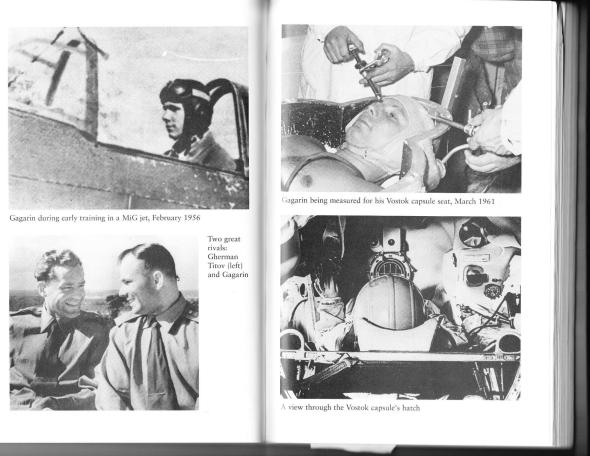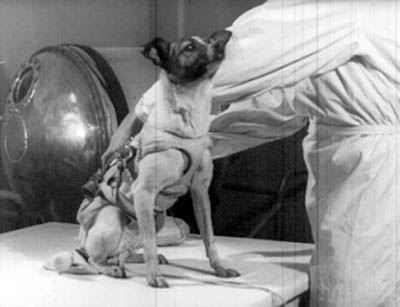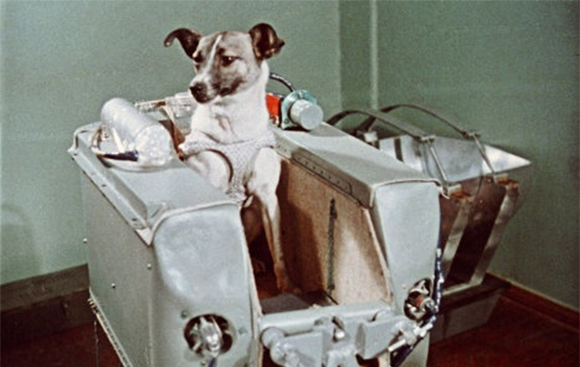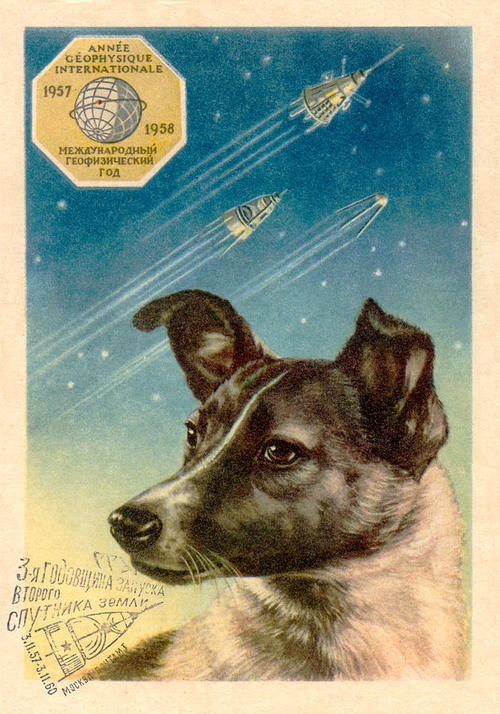Yuri Gagarin – The First Man in Space; April 12, 1961.
Yuri Gagarin was chosen because he had a more Russian sounding name versus his competitor, Titov. Also, Titov was considered smarter so they wanted to have the smarter man live in case something went wrong. There are other factors that played into it as well, such as Gagarin’s ability to show off his “Sovietness,” and his natural PR skills. His physical appearance was far behind on the list of reasons he was chosen.
Source: “The Cosmonaut Who Couldn’t Stop Smiling” – Andrew Jenks
A photographer waited for the ISS to sync up with Gagarin flight at the right place and time of day and recorded the earth then synced it up with the actual audio (NASA has combined Russian cosmonaut Yuri Gagarin’s audio from his historic flight with 1080p HD video from the ISS to simulate what Yuri experienced):
*After the flight, Yuri Gagarin eventually was banned for life from spaceflight due to his status as a national treasure and died at the age of just 34 in a jet crash in 1968.
The Soviet space program accomplished great things:
- 1957: First satellite, Sputnik 1
- 1957: First animal in Earth orbit, the dog Laika on Sputnik 2
- 1959: First rocket ignition in Earth orbit, first man-made object to escape Earth’s gravity, Luna 1
- 1959: First data communications, or telemetry, to and from outer space, Luna 1.
- 1959: First man-made object to pass near the Moon, first man-made object in Heliocentric orbit, Luna 1
- 1959: First probe to impact the Moon, Luna 2
- 1959: First images of the moon’s far side, Luna 3
- 1960: First animals to safely return from Earth orbit, the dogs Belka and Strelka on Sputnik 5.
- 1961: First probe launched to Venus, Venera 1
- 1961: First person in space (International definition) and in Earth orbit, Yuri Gagarin on Vostok 1, Vostok program
- 1961: First person to spend over 24 hours in space Gherman Titov, Vostok 2 (also first person to sleep in space).
- 1962: First dual manned spaceflight, Vostok 3 and Vostok 4
- 1962: First probe launched to Mars, Mars 1
- 1963: First woman in space, Valentina Tereshkova, Vostok 6
- 1964: First multi-person crew (3), Voskhod 1
- 1965: First extra-vehicular activity (EVA), by Aleksei Leonov, Voskhod 2
- 1965: First probe to hit another planet of the Solar system (Venus), Venera 3
- 1966: First probe to make a soft landing on and transmit from the surface of the moon, Luna 9
- 1966: First probe in lunar orbit, Luna 10
- 1967: First unmanned rendezvous and docking, Cosmos 186/Cosmos 188.
- 1968: First living beings to reach the Moon (circumlunar flights) and return unharmed to Earth, Russian tortoises on Zond 5
- 1969: First docking between two manned craft in Earth orbit and exchange of crews, Soyuz 4 and Soyuz 5
- 1970: First soil samples automatically extracted and returned to Earth from another celestial body, Luna 16
- 1970: First robotic space rover, Lunokhod 1 on the Moon.
- 1970: First data received from the surface of another planet of the Solar system (Venus), Venera 7
- 1971: First space station, Salyut 1
- 1971: First probe to impact the surface of Mars, Mars 2
- 1971: First probe to land on Mars, Mars 3
- 1975: First probe to orbit Venus, to make soft landing on Venus, first photos from surface of Venus, Venera 9
- 1980: First Hispanic and Black person in space, Arnaldo Tamayo Méndez on Soyuz 38
- 1984: First woman to walk in space, Svetlana Savitskaya (Salyut 7 space station)
- 1986: First crew to visit two separate space stations (Mir and Salyut 7)
- 1986: First probes to deploy robotic balloons into Venus atmosphere and to return pictures of a comet during close flyby Vega 1, Vega 2
- 1986: First permanently manned space station, Mir, 1986–2001, with permanent presence on board (1989–1999)
- 1987: First crew to spend over one year in space, Vladimir Titov and Musa Manarov on board of Soyuz TM-4 – Mir
The Soviet space program did face major problems in the 1960s. Their chief designer Sergei Korolev died in 1966 if I remember correctly and there was no similar genius to replace him. The Soviet N1 rocket which was supposed to be the equivalent to the Saturn V (the US moon rocket) never worked correctly and was a disaster. Because of the failure of the N1 the Soviets did not develop a rocket capable enough to deliver payloads beyond low orbit fast enough to catch up with the Apollo program. So, after 1969, the Soviets went a different way with their permanent space stations and were quite successful with it, more than the US.
The Soviets continued to send probes that landed on the surface of Mars and Venus. (You should look up the Vega program. They actually floated balloons in the atmosphere of Venus.) The USSR was the only country to operate semi-permanent space stations in near Earth orbit for decades, until the ISS was launched. Even today, they only way to send a person to the ISS is by using a Soviet/Russian designed Soyuz craft.
I highly recommend Starman: The Truth Behind the Legend of Yuri Gagarin for more information. There’s also been a wealth of declassified documents released from the former soviet archives in Russia regarding its space program.
Here’s a couple of pages from the book; (the one with Korolev is my favorite.):
And here are some more good sources and links. I find that a lot of Soviet stuff on some select English based media sites have a bad spin on it in their use of word-choices etc so I avoided the sensational sites and went for the more non-biased English ones or space expo ones.
http://www.spaceanswers.com/space-exploration/heroes-of-space-vladimir-komarov/
http://www.russianspaceweb.com/soyuz1.html
This is a great documentary about lives of Soviet cosmonauts during that era:
A similar instance in USA history would be the Apollo 1.
Like Komarov, the astronauts of Apollo 1 also knew about how bad, unsafe, and grim their chances were. One of the photos down the page show them half-jokingly praying to a model of the Apollo 1. However, unlike Komarov, the Apollo 1 never made it past the atmosphere . It blew up due to cabin fire during a rehersal.
NEVER FORGET!
May these brave representatives of our planet, rest in peace.
(While some Soviet space posters are outright political propaganda (socialism is our launchpad, sons of the revolution, etc.), most of them seem to be projecting a pride in the very real achievements of their space program and in/for the workers who built it, and to raise excitement about the space program. Most of the posters also don’t explicitly strike a contrast between the USSR and its rivals.)
*The United States also used propaganda to justify going to the moon… JFK basically told the american public that those dirty communists would use space to launch weapons at the US, so the US had to get there first.
Propaganda posters of Soviet space program 1958-1963:
V. Viktorov, Moscow, 1957.

Laika (c. 1954 – November 3, 1957) was a Soviet space dog who became one of the first animals in space, and the first animal to orbit the Earth.
Laika was a stray dog, originally named Kudryavka (Russian: Кудрявка Little Curly); she underwent training with two other dogs, and was eventually chosen as the occupant of the Soviet spacecraft Sputnik 2 that was launched into outer space on November 3, 1957, (becoming the first dog in space, to orbit the Earth, and was also the first animal to die in space.) The Soviets designed the spacecraft knowing she would not survive. One Soviet scientist took her home to play with his children because he said “I wanted to do something nice for her. She had so little time left to live.” Laika likely died within hours after launch from overheating, possibly caused by a failure of the central R-7 sustainer to separate from the payload. The true cause and time of her death was not made public until 2002; instead, it was widely reported that she died when her oxygen ran out on day six, or as Soviet government initially claimed, she was euthanized prior to oxygen depletion.
As a kid who was very into rockets and airplanes I remember being told about her (mind you, I wasn’t born until the cold war was ending), but in my childish innocence I assumed she came back okay.
Here’s a statement made by Oleg Gazenko, one of the Sputnik scientists:
“Work with animals is a source of suffering to all of us. We treat them like babies who cannot speak. The more time passes, the more I’m sorry about it. We shouldn’t have done it… We did not learn enough from this mission to justify the death of the dog.”
You know what makes me (sorta) happy? They built her a window. Despite the challenges and costs of building a secure window in a pressurized capsule, they did it so the dying dog could look out.
Source here:
Gazenko speaks of the bond that grew between the dog and him as they worked toward her mission, leading us in unembroidered prose through a brief tale of preparation, hours of readiness on the launch pad, and the launch itself. But the heart of the article for me, and the part to which nothing I’ve found since makes reference, is this: Gazenko tells us that as engineers rushed against deadlines to complete the capsule that would carry the dog into space, outfitting it with equipment to record the details of her death, he took on a battle in Laika’s behalf. Against heavy objections from the decision-makers, he insisted upon the installation of a window. A window in a space capsule, where such a luxury would cause complications and expenses that I can barely imagine. A window for the dog whose monitored demise had been this man’s objective in all the interactions that had bonded her to him with the eager devotion of every well-trained working canine.
Yet Gazenko persisted and prevailed.
Roof In Peace.









